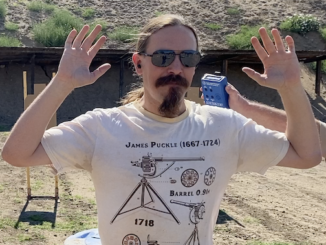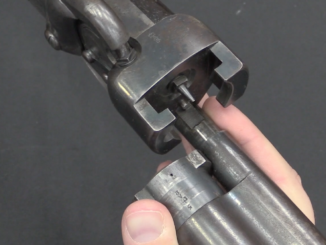While Rollin White’s patent for the bored-through cylinder was a massively important element in the development of Smith & Wesson as a company, White’s actual firearms design was impractical and never produced. In fact, there is only one firearm that actually bears his name – the solid frame .22 rimfire revolvers made by the Rollin White Arms Company. And yet, his association with that company is a bit mysterious and certainly not very deep.
The company was formed in 1864 and by 1865 had a contract to make rimfire revolvers for Smith & Wesson to resell. This implies some sort of cooperation with White himself, but White is not listed as an officer of the company at its foundation, and by 1865 it changed its name to the Lowell Arms Company, clearly indicating a break with White – whatever the initial association had been.
S&W bought all of the Rollin White and Lowell produced revolvers, 11,853 in total. They were marked “Manufactured for Smith and Wesson” in the same manner as the four brands of patent infringing revolvers that were sued by White and S&W. Later examples include a loading gate and ejector rod, but this early one is of the basic standard pattern. To reload, the cylinder is removed and the axis pin used as an ejector rod.




White was a troll but this gun is certainly ahead of the time. And the loading process seems quite familiar…
“White was a troll but this gun”
U.S.Patent system seems to be broken in that regard. If I am not mistaken, in 19th century, it was in theory communicating vessels with French, so this should knock-out White patent as Lefaucheux revolver (with bore-through chambers): https://en.wikipedia.org/wiki/Lefaucheux_M1858
was already in production.
For other exploit of U.S.Patent system see also: https://en.wikipedia.org/wiki/George_B._Selden
At the time, the U.S. and France had an agreement hat a patent in one country would be “respected” in the other, i.e. no “patent filching”.
This was at odds with White’s usual MO, which was to find a foreign patent, file it under his own name at the U.S. patent office, and then sue the foreign patentee in a U.S. court for infringing “his” patent. White was less an “inventor” than a con man and perpetual filer of nuisance lawsuits.
The LeFaucheaux patent was already “on record” when White obtained his patent. This indicates to me that either (a) a proper patent search was not done, either by White or the Patent Office, or (b) somebody “made sure” no such search was done. My guess would be Horace Smith & Daniel Wesson, who had the money to spread around after the Volcanic/New Haven Arms buyout by Oliver Winchester.
It’s worth noting that when S&W filed for an extension to the 12-year White patent, the U.S. Appeals Court pointedly asked why the patent had been granted in the first place in light of the pre-existing LeFaucheaux patent. S&W’s legal representatives had no believable (and legal) answer for this, and that was one factor causing the court to turn down the request for extension.
The LeFaucheaux patent is the most likely reason Samuel Colt turned White down when he brought the idea to him first. Colt was no legal genius, but even he understood the concept of “pre-existing patents”, having used them himself a time or two.
cheers
eon
If I am not mistaken, the US Patent Office had the reputation of the being one of the most corrupted administration of the time.
1864, no antisepsis, hardly any surgery available but for amputation, most people in general were smaller and often malnourished. Any bullet (or knife) wound in the midsection was guaranteed to be both painful and eventually fatal; even little slow bullets might pierce an eye socket from range, and a skull from close-up. And you had five chances, in contrast to a derringer; and rifling, in contrast to a pepperbox. As an item to keep away potential attackers brandishing fists, knives or canes, not that bad for its time. As an item to drop somebody charging at you with intent to commit mayhem, even this gun, in those times, might have been sufficient.
.22 Short itself is child of weaker cartridge: https://en.wikipedia.org/wiki/.22_BB
which has not powder charge at all (only primer)
–
In case of black-powder revolvers there are 3 interdependent things:
– momentum of fired projectile
– capacity
– compactness
improving one will have negative impact on at least one other
–
” And you had five chances, in contrast to a derringer; and rifling, in contrast to a pepperbox”
Still the most direct competitor seems to be percussion revolver in pocket size, which in that time means most probably .31 caliber (or less popular .28 caliber).
Why they decide to use .22 first, instead of say .30 (to avoid confusion with percussion .28 and .31) I don’t know, anyway I want to notice that to convince potential customer must be harder than, say for Spencer repeating rifle – in that case you can state that it is possible to fire much more times, than for single-shot rifle, when metallic-cartridge revolver does not have such advantage over percussion revolver, surely it is easier to load, but you must have access to cartridges.
One of the “dirty little secrets” of the revolvers of the Civil War era is that none of them were particularly powerful. Most generated muzzle energies under 170 foot-pounds, making them less powerful than relatively “weak” later metallic cartridge rounds such as the .38 S&W or the .380 ACP.
The muzzle energy of a standard conical-bullet load in the Colt Model 1860 Army .44 was about 850 f/s, yielding a ME of about 165 FPE. Incidentally, the .36 Navy fired its bullet, about 80 grains in front of 25 grains of powder, at about 950 F/S, yielding about 160 FPE. In short, there wasn’t a lot of difference in power between the two, but the .36 used less powder and lead to get the result.
Similarly, even such “exotic” weapons as the LeFaucheaux pinfire revolver (12,000 of which were issued to Union cavalry) were not particularly powerful by even the standards of a decade after the war. It launched its 200-grain bullet at 550 F/S, yielding a staggering 134 FPE.
I suspect most “instant fatality” cases from revolver bullets at the time were due to the shooter’s skill at shot placement more than anything else. Real revolver “killing power” began with such outsized guns as the .44 Colt Walker and Dragoon, or the British Adams .50 caliber double-action, which had large enough bullets driven by enough powder to generate energies over 400 FPE. The trend continued in the 1870s and 1880s in the U.S. with the .45 Colt round (255 gr @ 850= 410 FPE) or the .44-40 WCF (in a revolver, 210 @ 940= 412 FPE).
And no, the vaunted .455 Webley wasn’t much of a “stopper”. 265 grains at 600 f/s only gives 220 FPE; the standard British 200-grain load at 680 in the 0.380in Webley or Enfield of a half-century later delivered 205 FPE for a lot less gun weight.
Big bore does not always equal a lot of power. And in ballistics, as in auto safety, the first rule is “Speed Kills”.
cheers
eon
“One of the “dirty little secrets” of the revolvers of the Civil War era is that none of them were particularly powerful. Most generated muzzle energies under 170 foot-pounds, making them less powerful than relatively “weak” later metallic cartridge rounds such as the .38 S&W or the .380 ACP.”
Still even compared to then available alternative .22 [Short] rim-fire looks anemic.
“Big bore does not always equal a lot of power. And in ballistics, as in auto safety, the first rule is “Speed Kills”.”
But with then available technology (black-powder) high velocity (in our understanding of today) for revolvers (in general: short-barreled gun) was not possible, so the only way was to increase projectile mass, which in turn means bigger diameter.
Then came Minié ball and equivalents : increasing projectile mass & length for a given diameter.
“Then came Minié ball and equivalents : increasing projectile mass & length for a given diameter.”
Yes, still it can not be done in infinity, as too long bullet will have problems with stability-in-flight.
I still posit, this class of revolver was sufficient to frighten and sometimes to kill or sufficiently wound, and was not illogical to purchase. Of course S & W, et al, started small: copper, lead, and mercury fulminate were all expensive, and deciding the amount of metal to fabricate a cylinder sufficient to contain the discharge, was more guesswork than science. (Similar to the early semi-auto era when the first blowback pistol was in the now disrespected .32/7.65, and the ridiculously over-locked Frommer-Krnka-Roth pistols fired weaker cartridges than that.)
The advantages of any cartridge revolver over any percussion revolver are those of neatness (no powder, ball, loose lead, tamping or molds required), reliability (dampness can’t get to the powder or primer), and safety (easy to unload a cartridge gun without shooting). A remarkable number of Civil War accounts describe revolver gunfights in terms of contact shooting, or close enough to set the adversary’s clothes on fire. For the era, I modestly claim, this item would meet most needs.
About similarly sized №1:
“I was armed to the teeth with a pitiful little Smith & Wesson’s seven-shooter, which carried a ball like a homoeopathic pill, and it took the whole seven to make a dose for an adult. But I thought it was grand. It appeared to me to be a dangerous weapon. It only had one fault—you could not hit anything with it.”
Samuel Langhorne Clemens(for some reason better known as Mark Twain).
You can guess his opinion on pepper box guns, judging by the number of casualties inflicted upon livestock, particularly cows and mules.
Regarding the Allen pepperbox, Clemens wrote this quote from one character in “The Luck of Roaring Camp”;
“I should have shot that long, gangly lubber they called Hank if’n I could’ve done it without crippling six or seven others. Of course I couldn’t, the old Allen bein’ so consarned comprehensive.”
Accuracy was not the Allen’s, or any other pepperbox’s, strong suit.
Samuel Clemens started out as a riverboat pilot. He actually inherited the pen-name “Mark Twain” from an older pilot who wrote satirical articles for the St. Louis newspaper after his retirement. (It’s the old-time leadsman’s call, “By the mark twain!”, meaning two fathoms, or twelve feet, of water under the keel.)
He was later a newspaper reporter in San Francisco, during the Gold Rush.
With his background, you’d sort of expect him to know a thing or two, or even three, about guns.
cheers
eon
A small capacity steam-ejector refrigerator: experimental A small capacity steam-ejector refrigerator: experimental investigation of a system using ejector with movable primary nozzle Réfrigérateur de petite puissance à Soot Blower Lance Tube Corrosion – boilercleaning.
I see a small cylinder stop: maybe it is a one piece part, for example, a leaf spring. But what makes it to lower, when the cylinder rotates? The frame below the cylinder is very thin.
While helping with my families estate I found something similar but not quite the Model 1. I came across this video in my search and it was the first breadcrumb in the path to finding out what it actually was. Turns out Springfield was one of the companies made a copy of this (at least the cylinder) in .30 rimfire around 1863. They got sued by Rollin’s and stopped after a Six Thousand units. About 1500 were marked as stated and resold by S&W. Nearly 160 years later it ends up here. Thanks for this video!